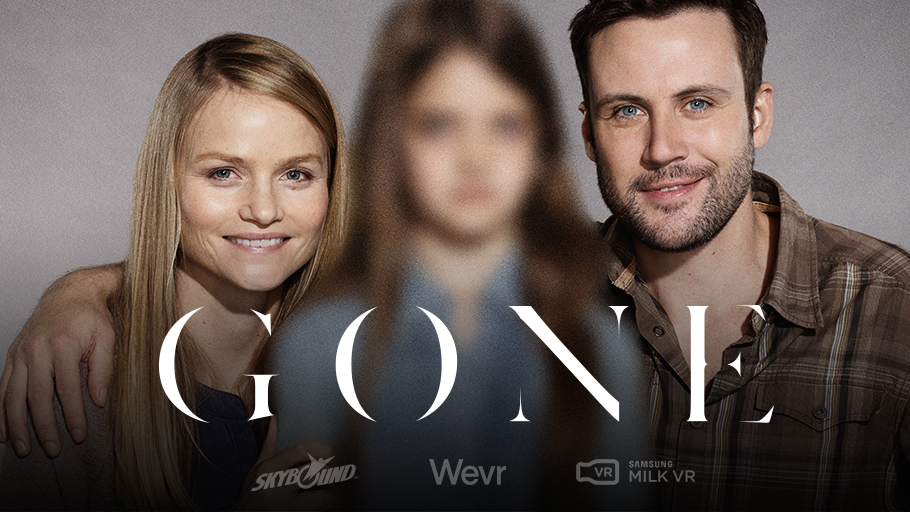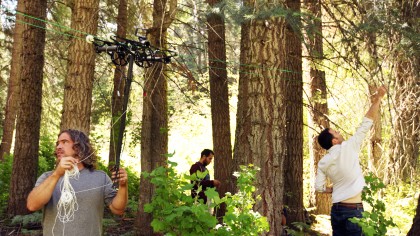Samsung's latest VR thriller, 'Gone', is something you have to experience
Virtual reality storytelling is getting better

The new VR series Gone, from Samsung and Robert Kirkman's Skybound Entertainment, is clear proof that virtual reality has made rapid progress during its recent resurgence, and is only getting better.
Written by JT Petty (of Outlast and Splinter Cell fame, among other projects), Gone tells a compelling story involving a desperate mother's search for her daughter, after she disappears in the middle of a crowded playground.
You're not the mother or the daughter, but an invisible observer tagging along and trying to solve the mystery for yourself.
Unless it's a defined, clear-cut game, most Samsung Gear VR experiences generally provide the same type of limited participation where you sit, look around and watch things happen.
There's nothing wrong with this formula because if done right, like Oculus Studios' film Henry, you get drawn into an emotional, well-written story.
Gone is similar to limited participation, but there's the added element of searching for clues, which improves the overall experience.
The clues are found in the form of 'hotspots', which are sprinkled throughout scenes in the 11 episodes of Gone, and provide unique perspectives that push the story forward while forcing you to dive deeper into the foreboding setting.
Sign up for breaking news, reviews, opinion, top tech deals, and more.
Hotspots often left me wondering if I was being shown a red herring or a genuine clue – which was both maddening and engrossing. To build even more suspense, you get a limited amount of time to find the hotspots and figure out the puzzle pieces. You can of course, replay the scene if you missed anything.
One of the hotspots that stood out for me was the missing daughter sitting alone, immediately before she vanishes, simply because it makes the broad daylight disappearance all the more baffling.
Another is a hanging piece of art, likely made by a child, but reminded me of the crude devil's nets from season one of True Detective.
Essentially, Gone set a tone that made me uneasy, yet left me wanting more. In fact, an inescapable feeling of dread was the last thing I expected to experience while tapping on hotspots and watching the scenes unfold.
Paired with well-timed, haunting music and the muted colors, it's almost like being inside a surreal indie horror film.
Making VR is harder than it looks
If you're wondering why there aren't more virtual reality experiences that include you as a major participant, it's because everything is still relatively nascent, with crazy new tools being developed as projects are being filmed.

Samsung Vice President of Strategy and Creative Content, Matt Apfel said the teams at Samsung and Skybound were making it up as they went along during the production of Gone because there hasn't been a distinct way to film and tell a cohesive story in VR.
Executive Producer Rachel Skidmore said new things were being tried every step of the way. Due to the omnidirectional aspect of the VR camera, heavily modified GoPro camera rigs were set up in an improvised manner while filming on location in a Sequoia forest.
Skidmore adds the crew had to hide behind trees while the actors needed to figure out different ways to execute scenes. She also noted that filming in VR leaves you "confined and fully exposed" while giving up a lot of control over the scenes. Rather than directing the camera, the audience is controlling where to look and when.

The technicalities of filming coupled with the story itself presented obstacles. Apfel notes that "collaborations were key" in solving problems. Tom Harding, Director of Immersive Products at Samsung, said both the writers and VR crew had to figure out ways to film scenes while preserving the narrative, how a person should come in and out of the view, camera orientations that weren't disruptive and so forth. Harding also reminisced about drawing diagrams on the forest floor to show how the scenes would need to work with the tech.
So what is Gone? A game? An experience? Other?
Gone VR Executive Producer and Co-Founder of virtual reality company Wevr, which helped create Gone, Anthony Batt says that the series is "native VR" or "VR video in its fullest."
Apfel backs this by stating they didn't just want to do a simple integration - rather Gone is a way to "push innovation, push storytelling" and that this is "the way we should be thinking about VR."
Thus there is no definite genre for Gone, though exploratory VR video or experience seem fitting. Batt says the leaders of VR "need to be brave" in their endeavors to show the audience something incredible.
Regardless of the nomenclature for this type of VR, it's evident that storytelling has evolved into a multifaceted medium that's both challenging, wonderfully refreshing and still learning as the industry continues to grow. It's safe to say that Gone is one of the experiences that's standing at the forefront of captivating virtual reality storytelling.
You can experience the first episode of Gone on December 8 from Milk VR through the Samsung Gear VR. More episodes in the series will follow in January in the form of two episode installments, though Samsung hasn't finalized how it will dole out the content.
Watch the teaser below for a sneak peek of Gone and prepare yourself to get sucked into the haunting mystery.